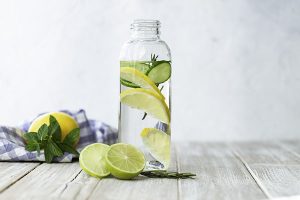Hydration quest
 A tall, cool drink of water is sure to quench your thirst—and keep your body functioning properly and feeling good. Makes sense, since our bodies are 70 percent water. In fact, most all of the body’s major systems depend on water to survive. Today, we hope to convince you to take another sip and stay hydrated!
A tall, cool drink of water is sure to quench your thirst—and keep your body functioning properly and feeling good. Makes sense, since our bodies are 70 percent water. In fact, most all of the body’s major systems depend on water to survive. Today, we hope to convince you to take another sip and stay hydrated!
What Water does for your body:
- Water regulates our body temperature. Your body is a perfect HVAC system: When it heats up, it releases water as sweat. Then the evaporation cools the body. Without this essential system, you’d overheat when you exert yourself or exercise.
- Water forms saliva and mucus. These slippery, moist substances aid in digestion, and they keep our nose, mouth and eyes moist. This moisture helps keep teeth clean, flushes grit from our eyes and prevents friction.
- Water protects body organs and tissues. When your skin is plump with water, it’s more resistant to premature wrinkles and skin disorders. On the inside, water keeps your blood thinner, helping regulate blood pressure.
- Water lubricates the joints. The cartilage in your joints and the disks of your spine are natural shock absorbers. They are about 80 percent water, so if you get dehydrated, your joints dry out and can’t absorb shock as well. Drink water to help decrease joint pain.
- Water aids digestion. Dehydration can lead to a host of digestive problems, including constipation, an overly acidic stomach, heartburn and stomach ulcers.
- Water supports the liver and kidneys. The kidneys regulate fluid in the body, while the liver filters or detoxifies your blood. With good hydration, your kidneys and liver don’t have to work so hard to flush out waste products. Dehydration can also lead to kidney stones, which can be enormously painful.
- Water dissolves many critical minerals and nutrients. This makes it possible for them to reach various parts of the body. Water also carries oxygen to cells.
How much water do I need?
Every day, your body loses water through the breath, perspiration, urine and bowel movements. So it’s important to continue taking in water throughout the day. There is no universally agreed-upon quantity for daily water intake. The Institute of Medicine suggests an “adequate intake” per day for women is 11 cups and for men, 16 cups—from all sources, including food, beverages and drinking water. While this is a good ballpark, water needs will be different depending on how much a person sweats and whether they live in a hot climate, are physically active or are coming down with an illness.
In general, you can trust your natural thirst mechanisms. If you feel thirsty, then drink more water. You also can pay attention to the color of your urine. It should be very pale or colorless and odorless (except for the first pee after waking up). For the average adult, going pee 4-10 times in a 24-hour period is considered normal.
Watch for symptoms of dehydration, including dry mouth, fatigue, constipation and decreased appetite. (Contact your health care provider if you experience the more severe symptoms of dizziness, elevated temperature, confusion and decreased blood pressure.)
Note: While water seems harmless, it can be dangerous to overhydrate. Taking in too much water can dilute your body’s electrolyte content. While rare, this can lead to water intoxication and possible death.
What’s the best source of fluids?
While all fluids and hydrating foods count toward your hydration, plain water is the best option because it has zero calories.
Caffeinated and alcoholic beverages tend to pull water from the body and make you urinate more, so while adding fluids you also lose more than with plain water. Sports drinks contain water, sugar, flavorings and minerals such as sodium and potassium. These drinks are marketed to imply that the ingredients are necessary to prevent dehydration, but even for athletes, the evidence for this is controversial.
Fruits and vegetables contain natural sugars and minerals, and are anywhere from 80 to 98 percent water. For example, watermelon contains 92 percent water, 8 percent natural sugar, and essential electrolytes such as, calcium, magnesium, potassium and sodium.
Forget to sip? Here’s a tip!
- Carry a reusable water bottle everywhere
- Drink water with meals and when ordering food out
- Chill water ahead of time if you enjoy a cooler temperature
- Set a timer for water consumption, download a hydration app or keep a daily “water log”
- Eat foods that are full of water, such as melon, cucumbers, celery and low-salt, broth-based soups.
- Create water intake challenges with friends and colleagues (see note above about overhydrating)
- Buy or make carbonated water
- Infuse water with non-calorie flavors—muddled mint leaves, cucumber, strawberries, or frozen citrus wedges or melon balls; food-grade flavor oils; a mint tea bag; sugar-free mixer
- Explore flavored waters such as Hint and other brands


